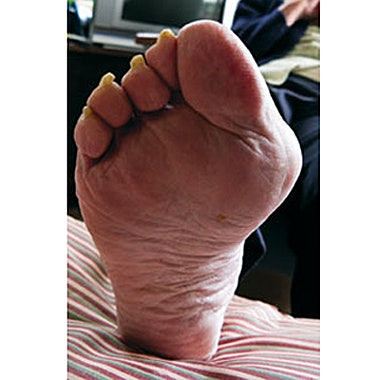
Bunion Basics
According to the American Podiatric Medical Association, a bunion (also known as hallux valgus) is an enlargement of the joint at the base of the big toe—the metatarsophalangeal (MTP) joint—that forms when the bone or tissue at the big toe joint moves out of place. Such a disjointed arrangement “involves some drifting of the great toe toward the lesser toes,” elaborates Carol Frey, MD, director of orthopaedic foot and ankle surgery at the West Coast Center for Orthopaedic Surgery and Sports Medicine in Manhattan Beach, California. This leads to a lump of bone on the inside of the foot, just below the big toe, which often causes pain.
Medical professionals believe there are multiple causes of bunion deformities. “Currently, the prevailing theory is that they’re caused by faulty biomechanics of the foot, which is largely an inherited trait,” says Thanh Dinh, DPM, member of Harvard Medical Faculty Physicians at Beth Israel Deaconess Medical Center in Boston. “It’s commonly thought that improperly fitting shoes cause bunions, but it is more likely that bunions are aggravated by these types of shoes and are not the cause itself.”
Because uncomfortable shoes can exacerbate the problem, women are particularly prone to bunions. Shoes that are too tight, notes Frey, “especially high-heel shoes with a narrow or pointed toe,” are often the culprit. Since women are most likely to cram their feet into these types of footwear, this leads to a much higher occurrence of bunions in women. Frey estimates that 90% of cases are reported by women, while Dinh suggests that women are predisposed to the problem over men by a 2-to-1 ratio.
Symptoms.
The symptoms of a bunion are easily detected. According to the American College of Foot and Ankle Surgeons (ACFAS), warning signs include pain or soreness, inflammation and redness, numbness in the affected area or a burning sensation. Other conditions that may appear are calluses on the big toe, sores between the toes, an ingrown toenail or restricted motion of the toe. Keep in mind that some clients may experience more symptoms and pain than others, depending on their activity levels and habits. “People who are on their feet for longer periods of time tend to be more symptomatic,” says Dinh. Athletes or dancers, for example, may have a higher incidence of irritation. Also, age is not necessarily a factor, as children and adolescents also experience bunions due to their foot type and genetics.
Nail Clinic: Bunions
Jun 26th, 2014











